Joint Products and By Products – CA Inter Cost and Management Accounting Study Material is designed strictly as per the latest syllabus and exam pattern.
Joint Products and By Products – CA Inter Costing Study Material
Question 1.
Narrate the terms ‘Joint Products’ and ‘By-Products’ with an example of each term. [CA Inter Dec. 2021, 5 Marks]
Answer:
Joint Products: Joint products represent two or more products separated in the course of the same processing operation usually requiring further processing, each product being in such proportion that no single product can be designated as a major product.
Example: In the oil industry, gasoline, fuel oil, lubricants, paraffin, coal tar, asphalt and kerosene are all produced from crude petroleum. These are known as joint products.
By-Products: These are defined as products recovered from material discarded in a main process, or from the production of some major products, where the material value is to be considered at the time of severance from the main product.” Thus by-products emerge as a result of processing operation of another product or they are produced from the scrap or waste of materials of a process.
Examples: Molasses in the manufacture of sugar, tar, ammonia and benzole obtained on carbonization of coal and glycerin obtained in the manufacture of soap.
Question 2.
Describe briefly, hew joint costs up to the point of separation may be apportioned amongst the joint products under the following methods:
(i) Average unit cost method
(ii) Contribution margin method
(iii) Market value at the point of separation
(iv) Market value after further processing
(v) Net realizable value method [CA Inter May 2009, Nov. 2010, 9 Marks]
Answer:
Methods of apportioning joint cost among the joint products:
(i) Average Unit Cost Method: Under this method, total process cost (upto the point of separation) is divided by total units of joint products produced. On division average cost per unit of production is obtained. The effect of application of this method is that all joint products will have uniform cost per unit.
(ii) Contribution Margin Method: Under this method, joint costs are segre-gated into two parts – variable and fixed. The variable costs are apportioned over the joint products on the basis of units produced (average method) or physical quantities. If the products are further processed, then all variable cost incurred be added to the variable cost determined earlier. Then contribution is calculated by deducting variable cost from their respective sales values. The fixed costs are then apportioned over the joint products on the basis of contribution ratios.
(iii) Market Value at the Time of Separation: This method is used for apportioning joint costs to joint products up to the split off point. It is difficult to apply if the market value of the products at the point of separation is not available. It is a useful method where further processing costs are incurred disproportionately. To determine the apportionment of joint costs over joint products, a factor known as multiplying factor is determined. This multiplying factor on multiplication with the sales values of each joint product gives rise to the proportion of joint cost.
(iv) Market Value after further Processing: Here the basis of apportionment of joint costs is the total sales value of finished products at the further processing. The use of this method is unfair where further processing costs after the point of separation are disproportionate or when all the joint products are not subjected to further processing.
(v) Net Realisable Value Method: Here joint costs is apportioned on the basis of net realisable value of the joint products,
Net Realisable Value = Sale value of joint products (at finished stage) (-) Estimated profit margin (-) Selling & distribution expenses, if any (-) Post split-off cost
![]()
Question 3.
Discuss the Net Realisable Value (NRV) method of apportioning joint costs to by-products. [CA Inter MTP]
Answer:
The realisation on the disposal of the by-product may be deducted from the total cost of production so as to arrive at the cost of the main product. For example, the amount realised by the sale of molasses in a sugar factory goes to reduce the cost of sugar produced in the factory.
When the by-product requires some additional processing and expenses are incurred in making it saleable to the best advantage of the concern, the expenses so incurred should be deducted from the total value realised from the sale of the by-product and only the net realisations should be deducted from the total cost of production to arrive at the cost of production of the main product.
Separate accounts should be maintained for collecting additional expenses incurred on:
- Further processing of the by-product, and
- Selling, distribution and administration expenses attributable to the by-product
Question 4.
How are By-products treated in Costing? [CA Inter Nov. 2018, 5 Marks]
Answer:
Treatment of by-product cost in Cost Accounting:
(a) When they are of small total value: When the by-products are of small total value, the amount realised from their sale may be dealt in any one the following two ways:
1. The sales value of the by-products may be credited to the Cost-ing Profit and Loss Account and no credit be given in the Cost Accounts. The credit to the Costing Profit and Loss Account here is treated either as miscellaneous income or as additional sales revenue.
2. The sale proceeds of the by-product may be treated as deductions from the total costs. The sale proceeds in fact should be deducted either from the production cost or from the cost of sales.
(b) When the by-products are of considerable total value: Where by-products are of considerable total value, they may be regarded as joint products rather than as by- products. To determine exact cost of by-products the costs incurred upto the point of separation, should be apportioned over by-products and joint products by using a logical basis.
(c) Where they require further processing: In this case, the net realisable value of the by-product at the split-off point may be arrived at by subtracting the further processing cost from the realisable value of by-products.
Question 5.
Distinguish between Joint Products and By-Products. [ICAI Module]
Answer:
Difference between Joint Products and By-Products.
| Joint Products | By-Products |
| Joint products are of equal importance. | By-Products are of small economic value. |
| They are produced simultaneously. | They are produced incidentally in addition to the main products. |
Practical Questions
Question 1.
A factory produces two products, ‘A’ and ‘B’ from a single process. The joint processing costs during a particular month are:
| Direct Material | ₹ 30,000 |
| Direct Labour | ₹ 9,600 |
| Variable Overheads | ₹ 12,000 |
| Fixed Overheads | ₹ 32,000 |
Sales: A – 100 units @ ₹ 600 per unit; B – 120 units @ ₹ 200 per unit.
Apportion joints costs on the basis of:
(i) Physical Quantity of each product
(ii) Contribution Margin method, and
(iii) Determine Profit or Loss under both the methods. [CA Inter Nov. 2019, 5 Marks]
Answer:
Total Joint Cost
| ₹ | |
| Direct Material | 30,000 |
| Direct Labour | 9,600 |
| Variable Overheads | 12,000 |
| Total Variable Cost | 51,600 |
| Fixed Overheads | 32,000 |
| Total joint cost | 83,600 |
Apportionment of Joint Costs:
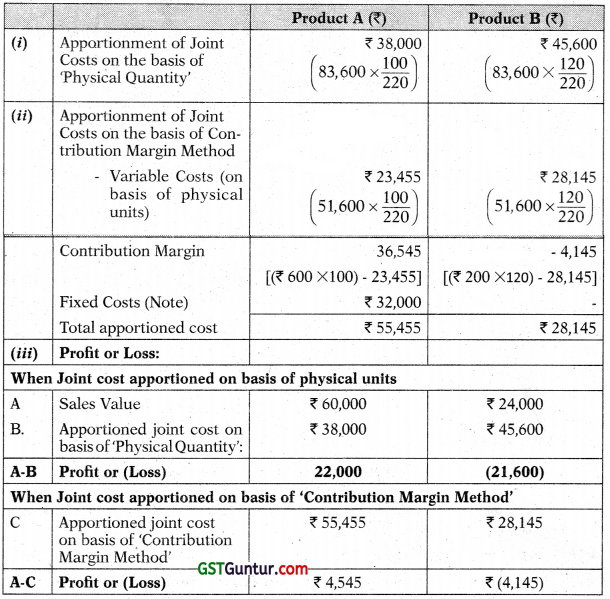
Note: The fixed cost of ₹ 32,000 is to be apportioned over the joint products A and B in the ratio of their contribution margin but contribution margin of Product B is Negative so fixed cost will be charged to Product A only.
![]()
Question 2.
A company’s plant processes 6,750 units of a raw material in a month to produce two products ‘M’ and ‘N’.
The process yield is as under:
| Product M | 80% |
| Product N | 12% |
| Process Loss | 8% |
The cost of raw material is ₹ 80 per unit.
Processing cost is ₹ 2.25.000 of which labour cost is accounted for 66%.
Labour is chargeable to products ‘M’ and ‘N’ in the raiio of 100:80.
Prepare a Comprehensive Cost Statement for each product showing:
(i) Apportionment of joint cost among products M’ and ‘N’ and (hi) Total cost of the products ‘M’ and ‘N’. [CA Inter Nov. 2020, 5 Marks]
Answer:
Comprehensive Cost Statement
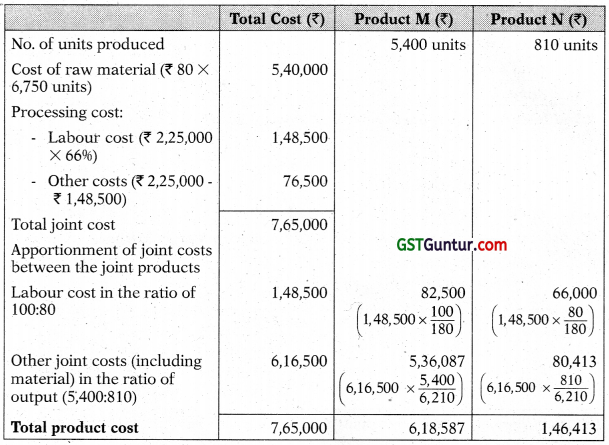
Note:
No. of units produced of Product M = 6750 units × 80% = 5400 units
No. of units produced of Product N = 6750 units × 12% = 810 units
Question 3.
Mayura Chemicals Ltd. buys a particular raw material at ₹ 8 per litre. At the end of the processing in Department- 1, this raw material splits-off into products X, Y and Z. Product X is sold at the split-off point, with no further processing. Products Y and Z require further processing before they can be sold. Product Y is processed in Department-2, and Product Z is processed in Department-3. Following is a summary of the costs and other related data for the year 2020-21:
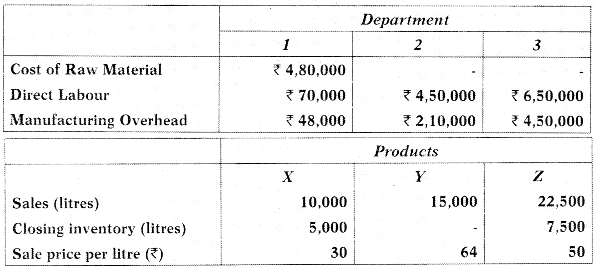
There were no opening and closing inventories of basic raw’ materials at the beginning as well as at the end of the year. All finished goods inventory in litres was complete as to processing. The company uses the Net-realisable value method of allocating joint costs.
You are required to prepare;
(i) Schedule showing the allocation of joini costs
(ii) Calculate the Cost of goods sold of each product and the cost of each Item; In Inventory.
(iii) A comparative statement of Gross profit. [CA Inter January 2021, 10 Marks]
Answer:
(i) Statement of Joint Costs allocation of inventories of X, Y and Z
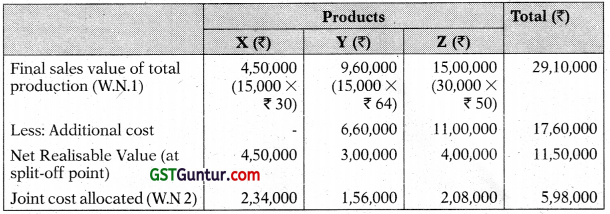
(ii) Calculation of Cost of goods sold and Closing inventory
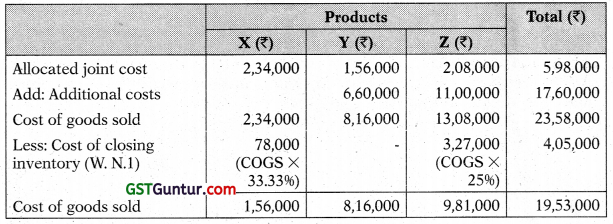
(iii) Comparative Statement of Gross Profit:

Working Notes:
1. Total production of three products for the year 2020-21

2. Joint cost apportioned to each product
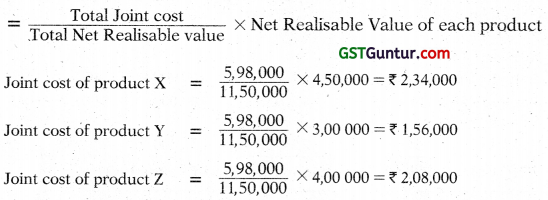
Question 4.
A Factory is engaged in the production of chemical Bomex and in the course of its manufacture a by-product Cromex is produced which after further processing has a commercial value. For the month of April 2021 the following are the summarised cost data:
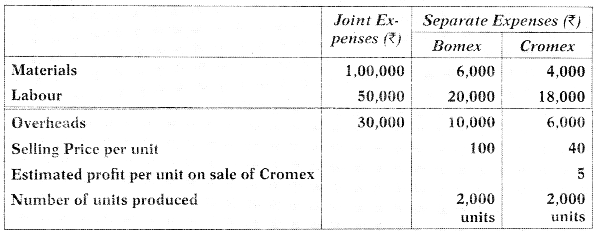
The factory uses net realisable value method for apportionment of joint cost So by products,
You are required to prepare-statements- showing:
(i) Joint cost allocable to Cromex
(ii) Product wise and overall profitability of the factory for April 2021, [CA Intel May 2019, 5 Marks]
Answer:
(i) Statement Showing Joint Cost Allocation to ‘Cromex’
| ₹ | |
| Sales (₹ 40 × 2,000 units) | 80,000 |
| Less: Post Split Off Costs (4,000 + 18,000 + 6,000) | (28,000) |
| Less: Estimated Profit (₹ 5 × 2,000 units) | (10,000) |
| Joint cost allocable | 42,000 |
(ii) Statement Showing Product Wise and Overall Profitability
| Bomex (₹) | Cromex (₹) | Total (₹) | |
| Sales Less: Share in Joint Expenses Less: Post Split Off Costs Profit |
2,00,000 (1,38,000) (36,000) |
80,000 (42.000) (28.000) |
2,80,000 (1,80,000) (64,000) |
| 26,000 | 10,000 | 36,000 |
Note: Share in Joint Expenses
For Bomex = ₹ 1,80,000 – ₹ 42,000 = ₹ 1,38,000 Treatment of By-Product Cost
Question 5.
A company manufactures one main product (M1) and two by-products B1 and B2. For the month of January 2021, following details are available:
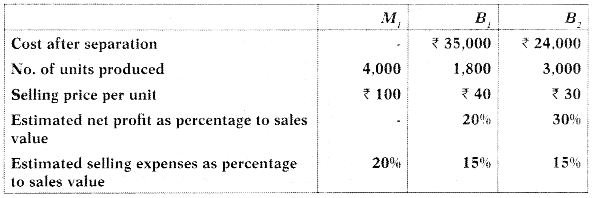
There are no beginning or closing inventories.
Prepare statement showing:
(i) Allocation of joint cost; and
(ii) Product-wise and overall profitability of the company for January [CA Intel May 2013, May 2015, 8 Marks]
Answer:
Statement showing allocation of Joint Cost
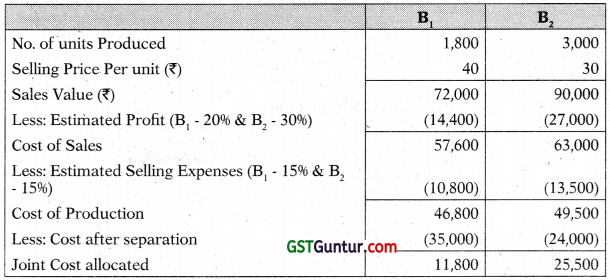
Statement of Profitability

![]()
Question 6.
A Ltd. produces ‘M’ as a main product and gets two by products – ‘P’ and ‘O’ in the course of processing.
Following information are available for the month of October, 2020:

The joint cost of manufacture up to separation point amounts to ₹ 2,50,000.
Selling expenses amounting to ₹ 85,000 are to be apportioned to the three products in the ratio of sales units.
There is no opening and closing stock. Prepare the statement showing:
(i) Allocation of joint cost
(ii) Product wise overall profitability and
(iii) Advise the company regarding results if the by product ‘P’ is not further processed and is sold at the point of separation at ₹ 60 per unit without incurring selling expenses. [CA Inter Nov. 2017, 8 marks]
Answer:
(i) Statement showing allocation of Joint Cost
| ₹ | ₹ | |
| No. of units Produced | 2,500 | 1,500 |
| Selling Price Per unit (₹) | 80 | 50 |
| Sales Value (₹) | 2,00,000 | 75,000 |
| Less: Estimated Profit (P – 30% & Q – 25%) | (60,000) | (18,750) |
| Cost of Sales | 1,40,000 | 56,250 |
| Less: Selling Expenses (Refer W.N.l) | (25,000) | (15,000) |
| Cost of Production | 1,15,000 | 41,250 |
| Less: Cost after separation | (60,000) | (30,000) |
| Joint Cost allocated | 55,000 | 11,250 |
(ii) Statement of Profitability

(iii) If the by-product P is not further processed and is sold at the point of separation:
| ₹ | |
| Sales value at the point of separation (2,500 units × ₹ 60) | 1,50,000 |
| Less: Joint cost | 55,000 |
| Profit | 95,000 |
| Profit after further processing | 60,000 |
| Incremental Profit . | 35,000 |
If the by-product P is sold at the point of separation, it will give an additional profit of ₹ 35,000 to the company, hence, the company should sell by-product P without further processing.
Working Note:
Calculation of Selling and Distribution Expenses

Selling and Distribution expenses for M = ₹ 85,000 – ₹ 23,000 – ₹ 15,000 = ₹ 45,000
Question 7.
A factory producing article A also produces a by product B which is further processed into finished product. The joint cost of manufacture is given below:
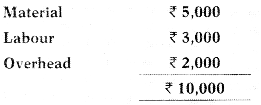
Subsequent cost in ₹ are given below:

Selling prices are A ₹ 16,000
B ₹ 8.000
Estimated profit on selling prices is 25% for A and 20% for B.
Assume that selling and distribution expenses are in proportion of sales prices. Show how you would apportion joint costs of manufacture and prepare a statement showing cost of production of A and B. [CA Inter Ma\ 2016 8 Marks]
Answer:
Apportionment of Joint Costs
| A (₹) | B (₹) | Total (₹) | |
| Joint costs | 6,733 | 3,267 | 10,000 |
| Add: Subsequent cost | 5,000 | 3,000 | 8,000 |
| Cost of production | 11,733 | 6,267 | 18,000 |
Working Note: Calculation of Selling and Distribution Expenses
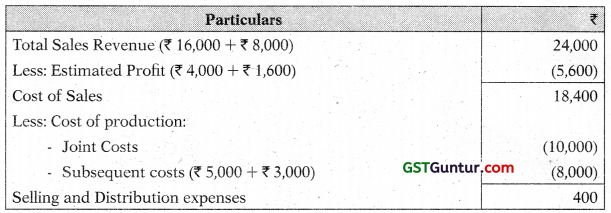
![]()
Question 8.
ABC Ltd. operates a simple chemical process to convert a single material into three separate items, referred to here as X, Y and Z. All three end products are separated simultaneously at a single split-off point.
Products X and Y are ready for sale immediately upon split off without further processing or any other additional costs. Product Z, however, is processed further before being sold. There is no available market price for Z at the split-off point.
The selling prices quoted here are expected to remain the same in the coming year. During 2019-20, the selling prices of the items and the total amounts sold were:
X – 186 tons sold for ₹ 3,000 per ton
Y – 527 tons sold for ₹ 2,250 per ton
Z – 736 tons sold for ₹ 1,500 per ton
The total joint manufacturing costs for the year were ₹ 12,50,000. An additional ₹ 6,20,000 was spent to finish product Z.
There were no opening inventories of X, Y or Z at the end of the year. The following inventories of complete units were on hand:
| X | 180 tons |
| Y | 60 tons |
| Z | 25 tons |
There was no opening or closing work-in-progress.
Required:
Compute the cost of inventories of X, Y and Z and cost of goods sold for year ended on March 31, 2020, using Net Realizable Value (NRV) method of Joint Cost allocation. [CA Inter Nov. 2020 RTP]
Answer:
Statement of Joint Cost allocation of inventories of X, Y and Z
(By using Net Realisable Value Method)
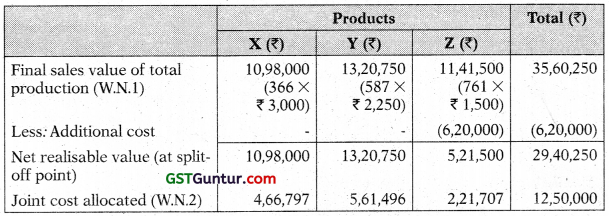
Cost of goods sold as on March 31, 2020
(By using Net Realisable Value Method)
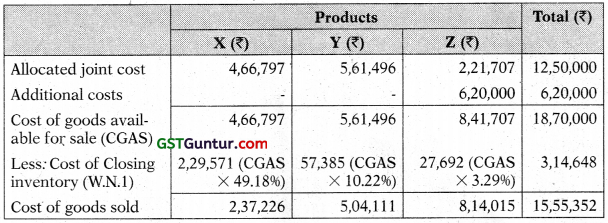
Working Notes:
1. Total production of three products for the year 2019-2020

2. Joint cost apportioned to each product:
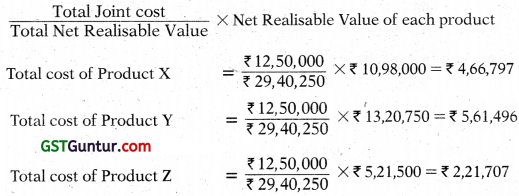
Question 9.
A Company produces two joint products P and 0 in 70: 30 ratio from basic raw materials in department A. The input/output ratio of department A is 100: 85. Product P can be sold at the split of stage or can be processed further at department B and sold as product AR. The input/output ratio is 100: 90 of department B. The department B is created to process product P only and to make it product AR.
The selling prices per kg. are as under:
| Product P | ₹ 85 |
| Product 0 | ₹ 290 |
| Product AR | ₹ 115 |
The production will be taken up in the next month.
Raw materials 8,00,000 Kgs.
Purchase price ₹ 80 per Kg.
| Dept. A ₹ lacs | Dept. B ₹ lacs | |
| Direct materials | 35.00 | 5.00 |
| Direct labour | 30.00 | 9.00 |
| Variable overheads | 45,00 | 18.00 |
| Fixed overheads | 40.00 | 32.00 |
| Total | 150.00 | 64.00 |
| Selling Expenses: | ₹ in lakhs |
| Product P | 24.60 |
| Product 0 | 21.60 |
| Product AR | 16.80 |
Required:
(i) Prepare a statement show ing the apportionment of joint costs
(ii) State whether it is advisable to produce product AR or not. [CA Inter May 2007, 8 Marks]
Answer:
Input in Dept. ‘A’ 8,00,000 kgs.
Yield 85%
Therefore Output = 85% of 8,00,000 = 6,80,000 kgs
Ratio of output for P and Q = 70: 30
Product of P – 70% of 6,80,000 = 4,76,000 kgs.
Product of Q = 30% of 6,80,000 = 2,04,000 kgs.
(i) Statement showing apportionment of joint cost
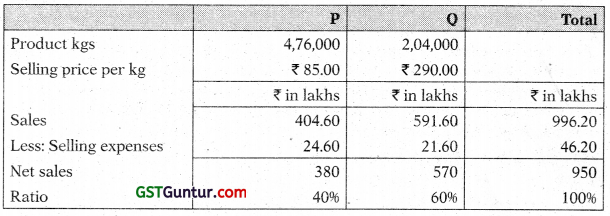
| ₹ in lakhs | |
| Raw materials (8,00,000 kgs. × ₹ 80) | 640 |
| Process cost of department ‘A’ | 150 |
| 790 |
Apportionment of Joint Cost
(In the ratio of Net Sales i.e. P : Q, 40% : 60%)
| Joint Cost of ‘P’ | ₹ 316 lakhs |
| Joint Cost of ‘Q’ | ₹ 474 lakhs |
(ii) Statement showing the profitability of further processing of product ‘P’ and converted into product ‘AR’

If ‘P’ is not processed, profitability is as under.
| ₹ in lakhs | |
| Sales Less: Joint expense |
380.00 316.00 |
| Profit | 64.00 |
Further processing of product ‘P’ and converting into product ‘AR’ is beneficial to the company because the profit increase by ₹ 31.86 lakhs (₹ 95.86 lakhs – ₹ 64.00 lakhs).
![]()
Question 10.
A company produces two joint products X and Y, from the same basic materials.
The processing is completed in three departments.
Materials are mixed in Department I. At the end of this process X and Y get separated. After separation X is completed in the Department II and Y is finished in Department III. During a period 2,00,000 kg. of raw material were processed in Department I, at a total cost of ₹ 8,75,000, and the resultant 60% becomes X and 30% becomes Y and 10% normally lost in processing.
In Department II1 /6th of the quantity received from Department I is lost in processing. X is further processed in Department II at a cost of ₹ 1,80,000.
In Department III further new material added to the material received from Department I and weight mixture is doubled, there is no quantity loss in the department. Further processing cost (with material cost) in Department III is ₹ 1,50,000.
The details of sales during the year are:
| Product X | Product Y | |
| Quantity sold (kg.) | 90,000 | 1,15,000 |
| Sales price per kg (₹) | 10 | 4 |
There were no opening stocks. If these products sold at split-off-point, the selling price of X and Y wouid be ₹ 8 and ₹ 4 per kg respectively.
Required:
(i) Prepare a statement showing the apportionment of joint cost to X and Y in proportion of sales value at split off point.
(ii) Prepare a statement showing the cost per kg of each product indicating joint cost, processing cost and total cost separately.
(iii) Prepare a statement showing the product wise profit for the year.
(iv) On the basis of profits before and after further processing of product
X and Y, give your comment that products should be further processed or not. [CA Inter May 2005, 9 Marks]
Answer:
Calculation of quantity produced

(i) Statement of apportionment of joint cost

(ii) Statement of cost per kg
| Product X | Product Y | |
| Output (kg) | 1,00,000 | 1,20,000 |
| Share in joint cost (₹) | 7,00,000 | 1,75,000 |
| Further processing cost (₹) | 1,80,000 | 1,50,000 |
| Total Cost | 8,80,000 | 3,25,000 |
| Total cost per kg (₹) | 8.80 | 2.708 |
(iii) Statement of profit
| Product X | Product Y | |
| Output (kg) | 1,00,000 | 1,20,000 |
| Sales (kg) | 90,000 | 1,15,000 |
| Closing stock | 10,000 | 5,000 |
| ₹ | ₹ | |
| Sales @ ₹ 10 and ₹ 4 for product X and Y respectively | 9,00,000 | 4,60,000 |
| Add: Closing stock (kg) (at full cost) | 88,000 | 13,540 |
| Value of production | 9,88,000 | 4,73,540 |
| Less: Share in joint cost | 7,00,000 | 1,75,000 |
| Further processing | 1,80,000 | 1,50,000 |
| Profit | 1,08,000 | 1,48,540 |
(iv) Profitability statement, before and after processing (assuming all units sold)

Product X should be sold at split off point and product Y after processing because of higher profitability.
Question 11.
In a chemical manufacturing company, three products A, B and C emerge at a single split off stage in department P. Product A is further processed in department 0, product B in department R and product C in department S. There is no loss in further Processing of any of the three products. The cost data for a month are as under:
| Cost of raw materials introduced in department P | ₹ 12,68.800 |
| Direct Wages Department | |
| P | ₹ 3,84,000 |
| o | ₹ 96,000 |
| R | ₹ 64,000 |
| S | ₹ 36,000 |
Factory overheads of ₹ 4,64,000 are to be apportioned to the departments on direct wages basis.
During the month under reference, the company sold all three products after processing them further as under:

There is no opening or closing stocks. If these products were sold at the split off stage, that is, without further processing, the selling prices would have been ₹ 20, ₹ 22 and ₹ 10 each per kg respectively for A, B and C.
Required:
(i) Prepare a statement showing the apportionment of joint costs to joint products.
(ii) Present a statement showing product-wise and total profit for the month under reference as per the company’s current processing policy.
(iii) What processing decision should have been taken to improve the profitability of the company?
(iv) Calculate the product-wise and total profit arising from your recommendation in (iii) above. [CA Inter May 2002, 12 Marks]
Answer:
(i) Statement showing the apportionment of joint costs to joint products

(ii) Statement showing product-wise and total profit for the month under reference (as per the company’s current processing policy)
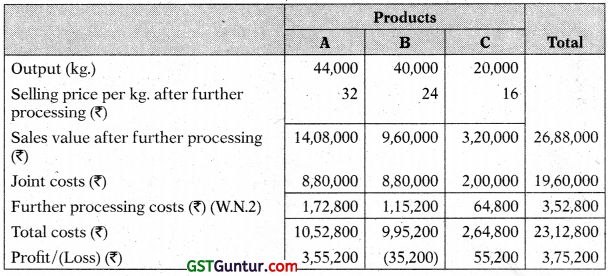
(iii) Processing decision to improve the profitability of the company
44,000 units of product A and 20,000 units of product C should be further processed since the incremental sales revenue generated after further processing is more than the further processing costs incurred.
40,000 units of product B should be sold at the point of-split off since the incremental revenue generated after further processing is less than the further processing costs.
(iv) The product wise and total profit arising from the recommendation in (iff) above is as follows:

Working Notes:

Joint costs and further processing costs
(i) Costs incurred in the department P are joint costs of products A, B and C and are equal to ₹ 19,60,000.
(ii) Costs incurred in the departments Q, R and S are further processing costs of products A, B and C respectively. Further processing costs of products A, B and C thus are ₹ 1,72,800; ₹ 1,15,200 and ₹ 64,800 respectively.
![]()
Question 12.
Pokemon Chocolates manufactures and distributes chocolate products. It purchases Cocoa beans and processes them into two intermediate products:
- Chocolate powder liquor base
- Milk-chocolate liquor base
These two intermediate products become separately identifiable at a single split off point. Every 500 pounds of cocoa beans yields 20 gallons of chocolate – powder liquor base and 30 gallons of milk-chocolate liquor base.
The chocolate powder liquor base is further processed into chocolate powder. Every 20 gallons of chocolate-powder liquor base yields 200 pounds of chocolate powder. The milk- chocolate liquor base is further processed into milk-chocolate. Every 30 gallons of milk- chocolate liquor base yields 340 pounds of milk chocolate.
Production and sales data for October, 2021 are:
- Cocoa beans processed 7,500 pounds
- Costs coprocessing Cocoa beans to split off point ₹ 7,12,500 (including purchase of beans)
Pokemon full processes both of its intermediate products into chocolate powder or milk- chocolate. There is an active market for these intermediate products. In October, 2021, Pokemon could have sold the chocolate powder liquor base for ₹ 997.50 a gallon and the milk-chocolate liquor base for ₹ 1,235 a gallon.
Required:
(i) Calculate how the joint cost of ₹ 7,12,500 wood be allocated between the chocolate powder and milk-chocolate liquor bases under the following methods.
(a) Sales value at split off point
(b) Physical measure (gallons)
(c) Estimated net realisable value, (NRV) and
(d) Constant gross-margin percentage NRV
(ii) What is the gross-margin percentage of the chocolate powder and milk-chocolate liquor bases under each of the methods in requirements (i) above?
(iii) Could Pokemon have increased its operating income by a change in its decision to fully process both of its intermediate products? Show your computations. [CA Inter Nov. 2004, 13 Marks]
Answer:
(i) Comparison of alternative Joint-Cost Allocation Methods
(a) Sales Value at Split-off Point Method

(3,000 lbs ÷ 200 lbs) × 20 gallon × ₹ 997.50 = ₹ 2,99,250
(5,100 lbs ÷ 340 lbs) × 30 gallon × ₹ 1,235 = ₹ 5,55,750
(b) Physical Measure Method
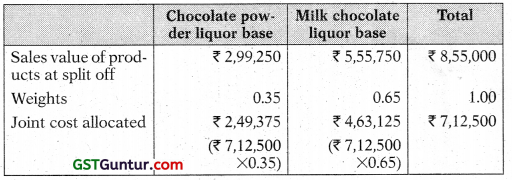

(3,000 lbs ÷ 200 lbs) × 20 gallon = 300 gallon
(5,100 lbs ÷ 340 lbs) × 30 gallon = 450 gallon
(c) Net Realisable Value (NRV) Method

(d) Constant Gross Margin (%) NRV method
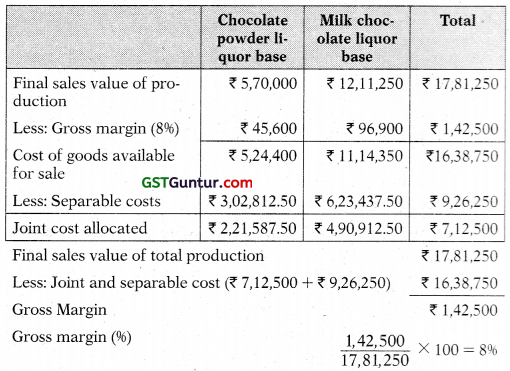
(ii) Chocolate powder liquor base

Milk chocolate liquor base
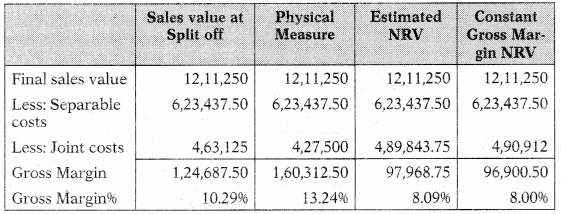
(iii) Further processing of Chocolate powder liquor base into Chocolate powder
| ₹ | |
| incremental revenue {₹ 5,70,000 – (₹ 99/ 50 × 300 gal Ion)} | 2,70,750.00 |
| Less: Incremental costs | 3,02,812.50 |
| Incremental operating income | (32,062.50) |
Further processing of Milk Chocolate liquor base into Milk Chocolate.
| ₹ | |
| Incremental revenue | 6,55,500.00 |
| [₹ 12,11,250 – (₹ 1,235 × 450 gallon)] | |
| Less: Incremental costs | 6,23,437.50 |
| Incremental operating income | 32,062.50 |
The above computations show that Pokemon Chocolates could increase operating income by ₹ 32,062.50 if chocolate liquor base is sold at split off point and milk chocolate liquor base is processed further.
![]()
Question 13.
Inorganic Chemicals purchases salt and processes it into more refined products such as Caustic Soda, Chlorine and PVC. In the month of July, Inorganic Chemicals purchased Salt for ₹ 40,000. Conversion cost of ₹ 60,000 were incurred upto the split off point, at which time two sealable products were produced. Chlorine can be further processed into PVC.
The July production and sales information is as follows:

All 800 tons of Chlorine were further processed, at an incremental cost of ₹ 20,000 to yield 500 tons of PVC. There was no beginning or ending inventories of Caustic Soda, Chlorine or PVC in July.
There is active market for Chlorine. Inorganic Chemicals could have sold all its July production of Chlorine at ₹ 75 per ton.
Required :
(1) Show how joint cost of ₹ 1,00,000 would be apportioned between Caustic Soda and Chlorine under each of following methods:
(a) sales value at split- off point;
(b) physical unit method, and
(c) estimated net realisable value.
(2) Lifetime Swimming Pool Products offers to purchase 800 tonnes of Chlorine in August at ₹ 75 per tonne. This sale of Chlorine would mean that no PVC would be produced in August. Explain how the acceptance of this offer for the month of August would affect the operating income? [ICAI Module]
Answer:
1. (a) Sales value at split-off point method

Apportionment of joint cost = \(\frac{\text { Total joint cost }}{\text { Total sale value }}\) × Sale revenue of each product
Joint cost apportioned to Caustic Soda = \(\frac{₹ 1,00,000}{₹ 1,20,000}\) × ₹ 60,000
Joint cost apportioned to Chlorine = \(\frac{₹ 1,00,000}{₹ 1,20,000}\) × ₹ 60,000
= ₹ 50,000
(b) Physical measure method
| Products | Sales (in Ton) | Joint Cost Apportioned (₹) |
| Caustic Soda | 1,200 | 60,000 |
| Chlorine | 800 | 40,000 |
| 1,00,000 |
Apportionment of joint cost = \(\frac{\text { Total joint cost }}{\text { Total Physical value }}\) × Physical units of each product
Joint cost apportioned to Caustic Soda = \(\frac{1,00,000}{2,000 \text { tonnes }}\) × 1,200 tonnes
Joint cost apportioned to Chlorine = \(\frac{1,00,000}{2,000 \text { tonnes }}\) × 800 tonnes
= ₹ 40,000
(c) Estimated net realisable value method:
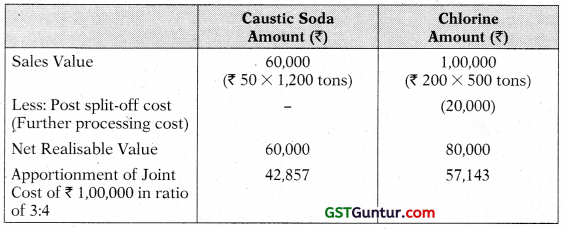
2. Incremental revenue from further processing of Chlorine into PVC
(500 tons × ₹ 200 – 800 tons × ₹ 75) × 40,000
Less: Incremental cost of further processing of Chlorine into PVC ₹ 20,000 Incremental operating income from further processing ₹ 20,000
The operating income of Inorganic Chemicals will be reduced by ₹ 20,000 in August if it sells 800 tons of Chlorine to Lifetime Swimming Pool Products, instead of further processing of Chlorine into PVC for sale.